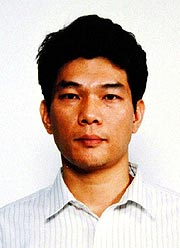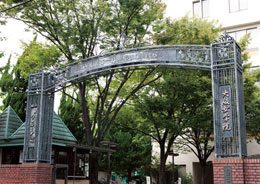
Ikeda is a city in Osaka Prefecture, Japan. As of 31 March 2023, the city had an estimated population of 103,064 in 49723 households and a population density of 4700 persons per km². The total area of the city is 22.14 square kilometres (8.55 sq mi). It is a suburban city of Osaka City and a part of the Kyoto-Osaka-Kobe metropolitan area.

Hirakata is a city in northeastern Osaka Prefecture, Japan. As of 31 December 2021, the city had an estimated population of 397,681 in 183075 households and a population density of 6100 persons per km2. The total area of the city is 65.12 square kilometres (25.14 sq mi).

Osaka City University (OCU) (大阪市立大学, Ōsaka shiritsu daigaku), abbreviated to Ichidai or Shidai (市大), is a public university in Japan. It is located in Sumiyoshi-ku, Osaka. It is one of the most prestigious universities in Japan regarding Applied Linguistics.

Osaka University, abbreviated as Handai (阪大), is a public research university located in Osaka Prefecture, Japan. It is one of Japan's former Imperial Universities, a Designated National University and listed as a "Top Type" university in the Top Global University Project. The university is often ranked among the top three public universities in Japan, along with the University of Tokyo and Kyoto University.

Osaka Prefecture University (OPU), also abbreviated to Fudai (府大), used to be one of the largest public universities in Japan.

Mamoru Takuma was a Japanese mass murderer who killed eight children in the Osaka school massacre in Ikeda, Osaka Prefecture, on 8 June 2001.

Osaka Jogakuin University is a private women's university in Osaka, Osaka Prefecture, Japan.

Osaka University of Arts is a private arts university located in Kanan, Minamikawachi District, Osaka Prefecture, Japan. The university was founded in 1945 as Hirano English Cram School, changing its name to Osaka School of the Fine Arts in 1957, and then to Naniwa University of the Arts in 1964. The university adopted the current name in 1966.

"Final Distance" is a song by Japanese recording artist Hikaru Utada for her third studio album Deep River (2002). Written by Utada herself, the song was produced and composed by long-time collaborators Akira Miyake, Utada's father Teruzane Utada and herself. "Final Distance" was originally recorded as "Distance" which was taken from the album with the same name, despite not being a single. The song was re-recorded, re-arranged, and dedicated to Rena Yamashita, a six-year-old victim of the Osaka school massacre who had written an essay about being inspired by Utada.
Soka University, abbreviated typically as Sodai (創大) or Sokadai (創価大), is a private university in Hachiōji, Tokyo, Japan. In 2014, the Japanese Ministry of Education, Culture, Sports, Science and Technology (MEXT) designated Soka University as one of Japan's Top Global Universities. The university has 8 faculties with a total of around 8,000 students, 400 of whom are international students.

Taipei Japanese School (TJS) is a Japanese international school located in Shilin District, Taipei. TJS was established in 1947 and mainly serves the children of Japanese expatriates in Taiwan.
Osaka University of Human Sciences is a private university in Settsu, Osaka, Japan. It is not the same as Osaka University, which is a National University and also hosts a Faculty of Human Sciences. The predecessor of the school was founded in June 1933, and it was chartered as a university in 2001.

Osaka Electro-Communication University, OECU is a private university in Japan. The main campus is located in Neyagawa-shi, Osaka Prefecture.
Atsushi Sakahara is a film director, writer, and producer. He now teaches at Kyoto Seika University and graduate program at Osaka City University. He is a former advertising executive at Dentsu inc who survived the 1995 sarin gas attacks in Tokyo, which led to his later film work. He produced the 2001 Short Film Palme d'Or winning Bean Cake, directed by David Greenspan. He directed a short film, Don't Call Me Father. in 2012. One of producers for the film was Paul Milgrom, who won Nobel Prize in Economics in 2020. In 2015 he began to work on what would become Me and the Cult Leader, a film following his pursuit of truth and justice by talking and travelling with current Aleph executive Araki Hiroshi. He is currently pursuing a Ph.D. in engineering at Utsunomiya University's school of regional development and creativity. He is also known as an inventor of the SA method, which is a unique idea-generation technique and application. He is a member of The Japan P.E.N Club. Olivia Rosenthal, a french novelist interviewed him in 2018 and released a novel based on it in 2022. He co-founded Logiglish Inc.., a language education company, with Kaho Fujikawa, his student at Osaka Metropolitan University. He founded Sarin Gas Attack Victims Association in 2022 for his experience that he was anti-democratically not allowed to join Tokyo Subway Sarin Gas Attack Victims Association represented by a widow without any particular reasons and list Japan National Police Agency in 2023.

Japanese School in Moscow is a Japanese international school located in Lomonosovsky District, South-Western Administrative Okrug, Moscow. It was established in 1967. It occupies the fourth and fifth floors of its building, which is also used by the Moscow Finnish School, the Swedish School in Moscow, and the Scuola Italiana Italo Calvino. The campus also has a dining hall, an indoor gymnasium, a technical classroom, a playing field that doubles as a skating rink in the winter, and outdoor athletic fields.

Taichung Japanese School is a Japanese international school in Daya District, Taichung, Taiwan in the Republic of China.

Osaka Tōin Junior and Senior High School is a private co-educational junior and senior high school located in Daitō City, Osaka Prefecture, Japan. The high school was founded in 1983 by Osaka Sangyo University.

Osaka Prefectural Kaifukan High School(Japanese: 大阪府立懐風館高等学校) is a public secondary school located in Habikino, Osaka, Japan.

Osaka Detention House is a correctional facility in Miyakojima-ku, Osaka. A part of the penal system of Japan, it is operated by the Ministry of Justice.
















